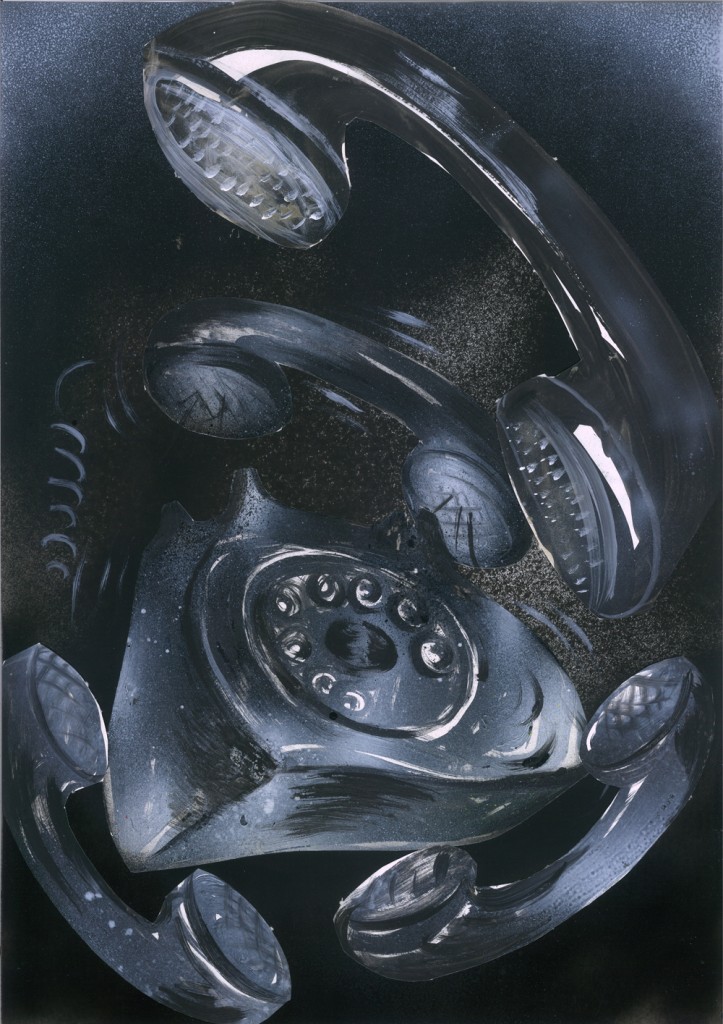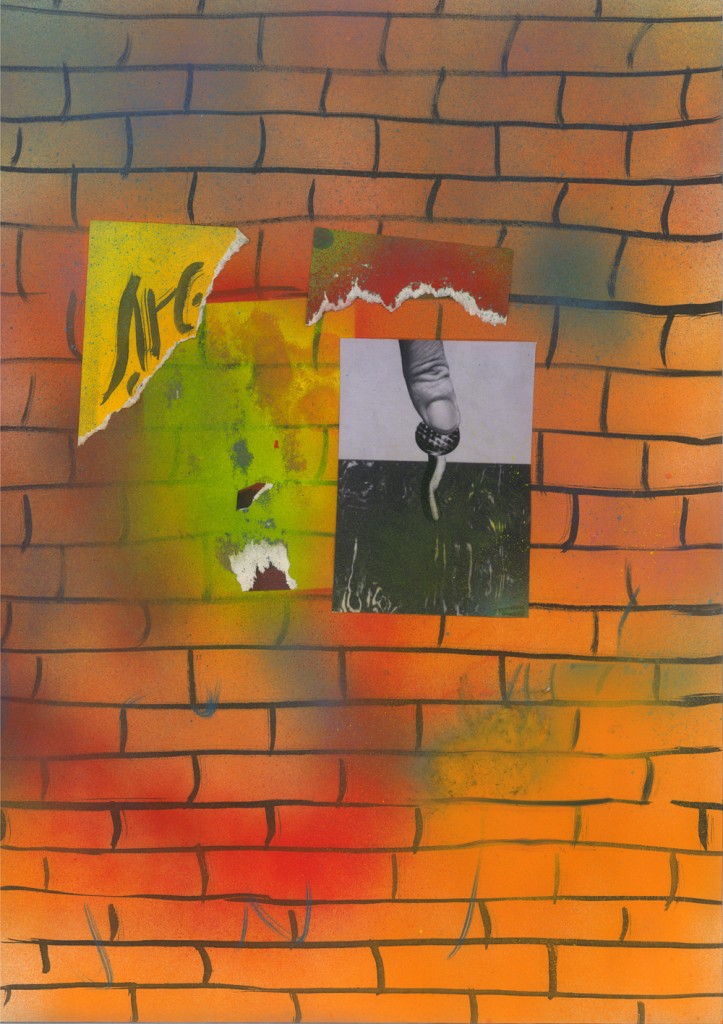Tomasz Kowalski / Posters
What does Tadeusz Kantor’s theatre have in common with metalwork art and the prose of William Burroughs?
Joanna Zielińska talking to Tomasz Kowalski on the occasion of the presentation of his drawings, in poster format, in urban space, during the 15 October – 4 November in Krakow (fragments). Part of the series The Migratory Museum.
Posters in urban space
The works which we have selected to function as posters were not originally created with the idea of such a manner of displaying them [in urban space – ed.], but with a certain convention in mind. They are small, their aesthetic reminiscent of the posters of the Polish School of Posters. They have no information content; they have been simplified to a visual sign. When you see them in public space, you start wondering what it is that you are looking at; they have clearly been printed by Cricoteka and they seem to be announcing something, but it’s not entirely clear what – perhaps a ghost spectacle?
Corporeity in the theatre
We have selected three out of a large series of works on paper, sparse both thematically and in terms of form; they consist of a few elements, simplified mass, humanoid forms. In one of the drawings, we can see abstract shapes with faces; the faces are anxious and tired, trapped in the cumbersome mass… Working on that drawing, I was thinking about corporeity, which has strong connections to the theatre.
Provincial existentialism
What matters a lot in my works is that the viewer should be uncertain in what period they were produced. Some look as if they’d been done in the past, but it’s impossible to say when precisely. These works are firmly grounded in the reality of Polish provincial life and art. For a while, I have been fascinated by unknown or in fact anonymous artists who worked towards the end of the communist era, painting existential paintings, weaving wall tapestries, and exhibiting them in the art galleries of small, provincial Polish towns. My parents had many catalogues of such works. In a sense, provincial existentialism can also be connected with Kantor.
Film noir and iconic film symbols
I am also fascinated by iconic symbols, situations and film scenes; ideas about a certain object which exist in group consciousness, such as, for instance, a phone ringing – an old-fashioned black telephone with a receiver on a flex. I associate it with film noir, with Polish bureaucracy in the People’s Republic, with a dusty old office, full of chain-smokers. These telephones are no longer in use, but everybody is very familiar with them. For a passer-by, the image of a ringing black telephone, its receiver jumping up and down, appears familiar, and such a simplified narrative contains both performativity and a theatrical quality. A phone ringing implies action: you run up to it, or pick up the receiver with curiosity. Sometimes, you reply, ‘Wrong number’.
Stage design
Another drawing is of a wall with ripped-up posters, with work of an artist – Agnieszka Polska – superimposed. This is a very stage-like construction, because the wall is drawn using cartoon technique. Drawing it, I didn’t have a real wall in mind, rather a stage prop. It looks like something out of the Muppet Show, a video clip of Michael Jackson or one of Cronenberg’s horror films. Everything has been very synthesised; it consists of a few simple elements. In this artificial situation, the real protagonist is Agnieszka’s work. So this poster, in a way, uses the technique of appropriation.
Everything is hanging by a thread
What fascinates me in Kantor’s spectacles is that they emanate the incredible determination of the actors, of Kantor himself, and of the entire reality that surrounds them. My father told me that, when he was watching one of his spectacles, in the Sokol Hall, a Krakow pigeon was flying over the stage. It must have flown in accidentally – or not so accidentally… Kantor saw the bird and started shouting something… and the bird flew down and sat on his shoulder. Perhaps this is why Kantor made Everything is Hanging by a Thread.* There is something in his spectacles that has a hypnotic effect on everybody, including the actors and the director. Everything is lunatic, time breaks down.
Pathos
There is no pathos in my works.
Childhood
I like references to childhood, but not in a pompous or melancholic or nostalgic sense. I am interested in childhood in the context of reflection on how one can perceive reality; how our consciousness builds on memories; how from what you remembered as a child you construct the pillars of your character and your attitude to life.
Metaphysical literature
Szczebrzeszyn is one of my main inspirations – a small Jewish town in the east of Poland, where I grew up. There is a dense, oneiric and grotesque atmosphere there, like in Bruno Schulz. By the way, the more I read William Burroughs, the more I think that they have a lot in common. Burroughs, and also Thomas Pynchon, have made a great impression on me. Metaphysical and psychedelic literature. The protagonists traverse the exotic expanse of a bazaar with things and scenes, losing themselves in the intensive, endless stage set. What intrigues in both writers is the complexity of the world that they have created. Especially so with Pynchon; each one of his books is a total work.
Sanatorium under the Sign of the Hourglass and Burroughs
I like the way that Has created the world in Sanatorium under the Sign of the Hourglass so much that I take no notice of the plot. I can look at parts of the film, rewind them, go back to scenes and details, as if I were looking at something through a window. Or as if I were a tourist on the set, stuck in a paused frame of the film, getting into each detail. It’s the same for me with Burroughs’s book The Western Lands, which is so intensive, that you could spend a whole day on just a single page of the text. During that time, you can ‘live’ the book, it’s like tripping, like being high.
Painting
There was a point when I wanted to do sculpture, painting and test myself in different media, but I got tired of it. I can’t be equally in touch with all the media. Recently, I again started to paint more, trying to translate into painting ideas which, not so long ago, I would have considered more suitable for a sculpture. Also, slightly different stories came into my paintings, a richer dictionary of elements; the world shown is more complicated and narrative. My paintings used to be more ornamental. Now I am capable of spending longer on any one work and think about it in a more mature way. They are less symbolic and less concrete, more film-like. Characters play a complex part, which makes them very theatrical. In the paintings I use similar props and attributes. I think about them as a performance, the stage and play acting. The same props, the same characters, which permeate different works. I use a number of elements; just like in the theatre where you also work with a number of particular props and actors and, together, you build up the structure. I think about history and iconography. I make choices, when it comes to the form, but the main idea stems from the fact that I want to relate a particular anecdote. That is how a painting is made.
A puppet theatre
I like puppet theatre, in its most traditional form, for aesthetic reasons. It’s a kind of aesthetics, which reminds me about childhood and the emotions which a creation such as a doll can inspire. Imagine the first time that a child encounters a doll, which looks like a person, but it is artificial and the child can control it.
Language
I make references to closed and finite aesthetics, such as metalwork art, graphics or a radio play. In fact, it’s similar in the case of painting. My language is based on irony and the grotesque.
A boring drug
Our band is called Boring Drug. We make music with percussion and synthesisers. We use New Age poetry, relaxation music and Krautrock (I mean the German psychedelic rock of the 60s, also known as kosmische Musik), but I have a feeling that this is only one of our incarnations. This can be linked to what I am doing in my painting – because in the band we also bring back various aesthetics from the past, in an ambiguous way. It’s great to work in a collective. When I paint, I make all the decisions; when I play, I am only responsible for part of the music.
* The exhibition of Tadeusz Kantor’s paintings, entitled Everything is Hanging by a Thread, took place in 1973 (Galeria Foksal, Warsaw); the first performances of Kantor’s spectacles at the Sokol Hall in Krakow – in 1980 [ed.]



Tomasz Kowalski: born in 1984 in Szczebrzeszyn, lives and works in Krakow. Mainly produces painting, but also works with other media such as installation, radio play or sculpture. In his art refers to various periods in history as well as stylistics, from German expressionism to the Polish School of Posters and provincial painting. Inspired by literature, puppet theatre, metalwork art, music of the late 80s and early 90s, and literature from Bruno Schulz to the psychedelic prose of William Burroughs and Thomas Pynchon. Recently, his works have become progressively more narrative; he keeps employing a store of similar props, characters and objects, which continue to be recycled the way theatrical props are.
Event organised as part of The Migratory Museum project.
Project The Migratory Museum subsidized by the Ministry of Culture and the National Heritage.
Partners: National Museum in Krakow, Barka Alrina, Institut International de la Marionnette de Charleville-Mézières, Région Champagne-Ardenne ORCCA, Instytut Historii Sztuki UJ.
Media patronage: Radio Kraków, O.pl, Cracow-life.com, E-splot.

